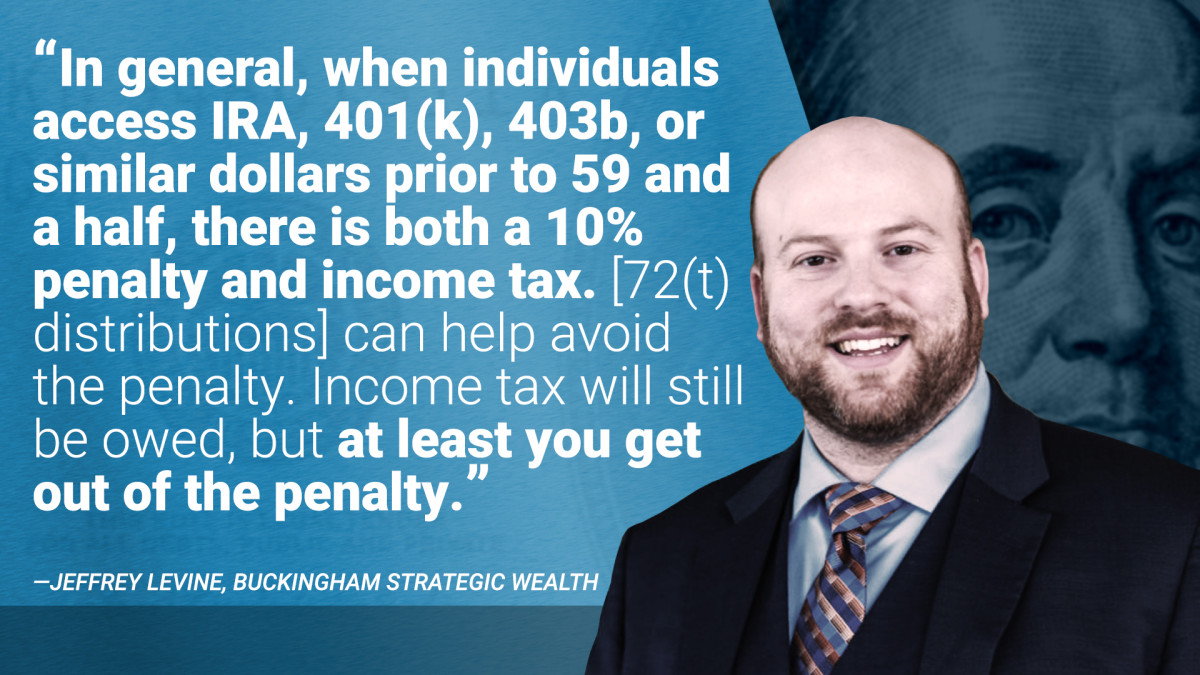Rule 72(t) refers to a section of the Internal Revenue Code that allows taxpayers to make early withdrawals from certain qualified retirement accounts—like a 401(k) or an individual retirement account (IRA)—without paying extra penalties.
Retirement Daily’s Robert Powell caught up with Jeffrey Levine, CPA and tax pro from Buckingham Strategic Wealth Partners, to discuss everything you need to know about 72(t).
TurboTax Live experts look out for you. Expert help your way: get help as you go, or hand your taxes off. You can talk live to tax experts online for unlimited answers and advice OR, have a dedicated tax expert do your taxes for you, so you can be confident in your tax return. Enjoy up to an additional $20 off when you get started with TurboTax Live.
Quotes| Rule 72(t) – Everything You Need to Know Jeffrey Levine, Chief Planning Officer, Buckingham Strategic Wealth Jeffrey Levine, Chief Planning Officer, Buckingham Strategic WealthRecommended Read: Tax Tips for Retirement
Video Transcript| Jeffrey Levine, CPA and Tax Expert, Buckingham Strategic WealthRobert Powell: What is 72(t) and what do you need to know about it? Well, here to talk with me about this is Jeffrey Levine from Buckingham Strategic Wealth. Jeffrey, welcome.
Jeffrey Levine: It’s good to be with you, Bob.
Robert Powell: So it might sound like mumbo jumbo, but 72(t) does mean something.
Jeffrey Levine: Well, 72(t) distributions are a way to get access to retirement dollars prior to 59 and a half without paying the 10% penalty. In general, when individuals access IRA, 401(k), 403b, or similar dollars prior to 59 and a half, there is both a 10% penalty and income tax. This can help avoid the penalty. Income tax will still be owed, but at least you get out of the penalty.
Now, what is a 72t distribution? Well, in short, the tax code defines this as what is a series of substantially equal periodic payments, which sounds even more complicated than 72(t) distributions themselves. So what does that mean? Well, it means that based on a number of factors, there are IRS-prescribed methods for calculating these distributions. We put in your account balance. We input certain other things, such as an IRS-approved interest rate, and your life expectancy based on a number of tables. And we come up with a payment that effectively pseudo annuitizes your account over your lifetime. So you don’t really annuitize it. It’s almost like a make-believe annuity that you take from your account. And by doing so, and by following very, very rigid and specific rules, you’re able to avoid the 10% penalty on those distributions.
But the 72(t) payments must last for the longer of five years, or until you reach 59 and a half, again, whichever of those is longer. And if you make any mistakes in the interim, well, not only could it cause penalties for the distribution that was taken in error, but it will trigger retroactive penalties and interest on all those 72(t) distributions that were taken to date.
Editor’s Note: The content was reviewed for tax accuracy by a TurboTax CPA expert.
Zach Faulds contributed to the writing of this article and produced the video and/or the graphics associated with it.
